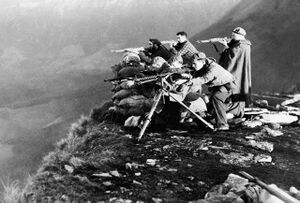Amonian Civil War
| Amonian Civil War | ||||||||
|---|---|---|---|---|---|---|---|---|
 A small communist guerrilla outpost sits in the mountains of Amon, circa. 1925. | ||||||||
| ||||||||
| Belligerents | ||||||||
| Communist Party of Amon (1921-1933) | 2nd Kingdom of Amon (1921-1929) | Republic of Amon (1924-1933) | ||||||
| Commanders and leaders | ||||||||
|
Chairman Lenin (People's Commissar for Military Affairs) |
King Pyaro (Commander-in-Chief of the Royal Amonian Armed Forces) |
General Wen (Generalissimo of the Republican Army) | ||||||
| Strength | ||||||||
|
Communists: 10,000 (1921-1924) |
2nd Royal Army: 180,000 (1921-1924) |
Republicans: 80,000 (1924-1929) | ||||||
| Casualties and losses | ||||||||
| Communists: 80,000 | Royalists: 105,000 | Republicans: 65,000 | ||||||
| Civilian Casualties: between 150,000 and 320,000. | ||||||||
The Amonian Civil War was a large, drawn out conflict in what is today the country known as Posadastan. It was a multi-faceted civil war with many different sides and issues at play. But, it laid the foundation for the modern state of Posadastan to exist.
History
pretext
The civil war really began with an event known in Posadastan as the 222 Incident, where on Febraury 22nd, 1921, the Royal Army of Amon put down a general strike in the capital city, killing an estimated 230 striking workers and civilians. However, before this even took place, the collapse of the State of Amon in 1890 and the subsequent ban on the Amon Communist Party (ACP) in 1891 angered many leftists and forced most organization to go underground, this included labor unions. The violent crackdowns on labor and communist movements, as well purges against anyone deemed sympathetic to such movements led to widespread disillusionment with the monarchy.
Phase 1
Underground Communists and trade unionists took up arms, carrying out occasional urban guerrilla attacks, but mostly being forced into the forests, mountains and jungles. This relatively low-level insurgency lasted from March 1921 to June 1924. Most deaths in this period were the result of government massacres and purges, while the communists focused on attacking military infrastructure and important figures in Amonian political and economic spheres.
Phase 2
In June of 1924, while addressing a crowd of soldiers, the King was shot at and nearly killed by a soldier in the crowd, who yelled “Death to the King!” This caused the King to suspend the parliament and put into place nation-wide martial law, causing the more moderate democratic sympathizers and disillusioned military officers to create a third side to the civil war. The “Republicans” managed to occupy a large chunk of the north, and even occupied a couple southern garrisons, while the communists were resigned to the northwest and west. The republicans were wary of the communists, but the two sides often avoided fighting each other. This period of fighting lasted until April of 1929.
Phase 3
In April of 1929, many indigenous groups began joining or allying with the communists, leading to communist advances and the general fear that they may seize the capital before the republicans. This led to the royalist government capital garrison to arresting and threatening to prosecute and execute the king so that they could join the republicans and avoid communists taking over. However, the King, aided by his few remaining supporters, escaped before his execution to an area further south. The capital garrison proceeded to join the Republicans, though most other garrisons went their own way, or even joined the communists. This period lasted until the latter part of July 1929, when communist forces seized the King's last royalist stronghold and brutally killed the entire royal family after a mock trial.
Phase 4
In July of 1929, the Republicans controlled most of the country; however, areas like the capital still had a heavy presence of underground communist activity, such as unions, many of whom were soon thereafter forcefully disarmed by the republicans. After the communists had seized the southernmost strongholds and executed the entire royal family, the republicans executed several key communist ringleaders and union officials in the major cities, causing some of the remaining warlords to join them, but this also began causing constant riots and protests against Republican rule. This period lasted until September of 1933, when the last remaining Republican-aligned warlord/stronghold surrendered to Communist advances as internal strife had severely weakened the Republicans, and mass defections saw their ranks become empty.
Consequences
With the communist victory, after 12 long years of fighting, the took control of Amon, establishing the People's Republic of Amon. But they also decided to take revenge, and did so on a massive scale. This led to instability well into the 1940s and its effects continued to seen through the 1970s and 80s.